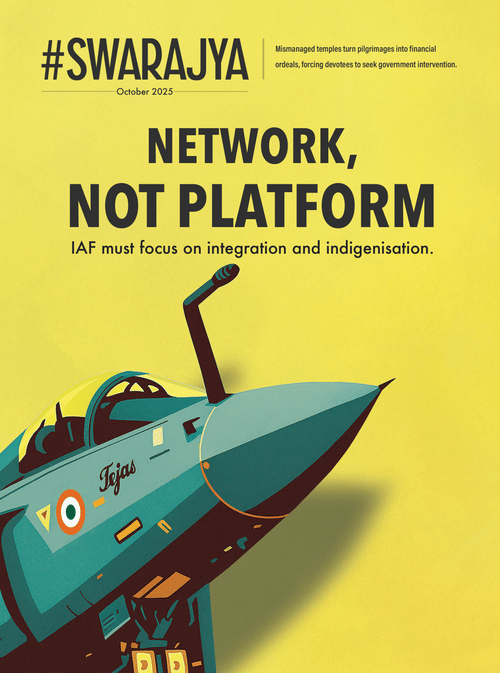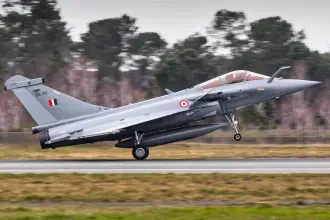Culture
An Eco-Dharmic Exploration of the Water Heritage Of Varanasi
Aravindan Neelakandan
Apr 02, 2023, 10:03 PM | Updated 10:03 PM IST
Save & read from anywhere!
Bookmark stories for easy access on any device or the Swarajya app.


The Sacred Waters ‘of’ Varanasi: The Colonial Draining and Heritage Ecology. Mahesh Gogate. Manohar Publishers. Pages 192. Rs 1195.
The traditional water-harvesting and management structures in the holy cities of India are among the most neglected aspects of the contemporary development of these cities as major pilgrimage centres.
They are not even considered as ancient heritage structures.
Often, it is only a lingering sense of sacredness in the civilisational memories which saves them; but most are either endangered or extinct.
This is true of many ‘Teertha Kshetras’ of India. Painfully, it is also true of one of the most sacred of the ancient cities of Hindus – Varanasi.
In this thesis-turned-very-readable-book, Mahesh Gogate, an affiliated researcher at Kyoto University, has combined the vision of a historian with that of a holistic urban development planner with specific focus on the traditional water management systems of Varanasi.

The subject matter of the book is vital to those who envision a revival of the ancient cities of India. It deals with how colonial and colonised policy-makers have systematically and/or ignorantly destroyed the traditional water-management systems which existed in the form of temple tanks and ponds.
The gleaning of geo-hydrological knowledge from the ancient sacred literature by the author provides a strong methodological opening to what are all the different ways we can approach this literature and more importantly how the sacred literature opens its secrets to those who approach it with genuine curiosity.
Here is an unravelling of a Puranic allegorical description of Kasi:
Varansi is heavenward and positioned on the tip of the trident (trisula) of Siva and did not submerge even during the deluge (pralaya). These three tips of the trident are the three embankments commonly referred to as three divisions (khanda) of the city namely Omkara Khanda in the north, Visvesvara Khanda in the middle and Kedara Khanda in the south.(p.35)
In the chapters that follow what gets unveiled before the readers is a grand 'water culture' that defies easy categorisation because it is an integral part of Hindu life in all its dimensions, sacred and secular.
The author has gone through all the sacred literature and has matched the literary data with the data of geographical, cultural and historical realities.
The Kasi Khanda of Skanda Purana provides the author with the details of the temple tanks, ponds, lakes, streams etc.
These water bodies along with the rituals and worship associated with them form an integral part of the temple architecture.
The Kasi Khanda lists not less than 281 ‘titled water reservoirs’. Dr. Gogate categorizes them into eight – tirtha, kunda, pushkarini, vapi, hrada, dirghika, sarovara and nala.
Further, leaving out the tirtha, the remaining seven categories are divided into natural and man-made type of water management bodies. Kunda, Pushkarani and Vapi are man-made.
The author also uses the voluminous work of Swami Medhasananda on Varanasi. He further states that these 281 water bodies have qualitative descriptions of their structural features, geographical location and settings, etymology and activities to be conducted by the side of or in the water bodies.
The chapter titled ‘the Tale of Two Maps’ takes a nuanced look at inter-civilizational knowledge fertilization. The two maps discussed here are the map made by James Prinsep in 1822 and another pictorial map titled ‘Pilgrims’ map of Benares’ drawn in 1875.
Prinsep's map, points out Gogate, ‘was an empirical representation of the colonial city’, which does not need ‘any supplementary knowledge or context.’ The objective of making this map according to Prinsep was ‘to aid administrative and military requirements.’
Prinsep's map of 1822 empowered the colonial administration to impose the property tax, construct roads and railway lines and introduce the central water supply. ... The map revealed subtly the land and water separation and distinguished the dry and wet attributes of the topography. ... The representation of the water was purely in the secular form and appeared as a resource, whereas the land represented the notion of property.(pp.91-2)
As against this the ‘pictorial map of Varanasi’ according to Gogate,
...with its westward orientation hints at the natural slope and a high natural embankment on the River Ganga. The peculiar arrangement of the various sacred zones and the water pools point out that the map maker was probably aware of the Puranas and other literary texts that provide detailed spatial information about the region. ... The map reveals the continuum between land and water. The careful observation enables one to see the flow pattern of the city and epitomizes the notion that water is omnipresent in Varanasi. The mapmaker of the pictorial map subtly hints at the sacred landscape of Varanasi which is not static but dominated by flowing water.
The fact of colonial and subsequent history is that the mapping was done more on the lines of Prinsep’s map.
The chapter ‘Draining the City’ makes a painful reading.
How the colonial administration not only destroyed the ecologically meaningful water system of the sacred city but also used those ensuing ill-effects to further their destruction of the traditional water harvesting and management systems of the city.
Festive congregations and ceremonial bathing in the river became the targets of colonial administration. Every non-running water body like ponds were considered as the source of disease and were filled in.
In 1868, Reverend Sherring justified the draining and elimination of Matsyodari pond by James Prinsep on sanitary grounds. Gogate notes that ‘the drying up of the Matsyodari Tirtha resulted in the decline in devotees visiting the temple of Kamesvara located on the eastern banks of Matsyodari Talaba.’ (p.105)
Prinsep also dried up another prominent Tirtha called Mandakini Talaba.
This pond, which was part of a series of ponds parallel to Ganga, also had in it more than 1,500 turtles.
These were removed from their original habitat.
Prinsep knew about the adoration Hindus had for turtles and their habit of feeding them. Gogate observes that the number of turtles indicated the spread of the water reservoir and its functional nature. (p.109).
This urbanisation-evangelism mission progressed well and unchecked into 20th century as well.
Edwin Greaves of the London Missionary Society studied the city and published a book in 1909. He appreciated the municipal administration for filling up the Beniya Talaba, another Teertha ‘by replacing the filthy wetland into a park.’ (p.120).
There is even more. The colonial administration was also de-Hinduising the landmarks of Varanasi:
The colonial rule changed the urban morphologies of the city and converted it into a modern dry city by eliminating the stagnant water pools. The Benares Guide Map published in 1928 signifies the transformation of temple tanks and ponds in terms of forms and reduced expenses. ... The 1928 guide map showed that the names of many temple tanks and ponds were changed, and some names even indicated the colonial impression on it. For example, Mandakini Tirtha was mentioned as Mandakini Talana in the 1822 map by James Prinsep and later the title was changed into Public Garden. Similarly the earlier name Veni Tirtha was changed into Beniya Talaba and later appeared as Victoria Park on the 1928 guide map.(pp.12-22)
On the whole the chapter describes a systematic ecocide and cultural-ethnic cleansing happening at the very heart of Sanatana Dharma.
Coming from Kanyakumari district this is a familiar feeling.
In the early decades of 18th century, the British ‘Company’ Reagent Colonel Monroe, who was a fundamentalist evangelist, appointed a missionary, Charles Mead of London Mission, as magistrate of Nagercoil town (the present district capital of Kanyakumari district).
Mead used the convict labour effectively to not only build Christian institutions but also destroy the cultural structures of Hindus. As a civil judge with the backing of the Reagent he removed and transported the huge dressed stones ... 'from the dyke of the tank near the temple of Nagaraja with the help of the elephants and the prisoners.'
Today a stadium stands in the place of the tank.
In his diary, Mead wrote that while the glory of the Church he built should increase the very temple from whose tank he removed the stones, should soon disappear.
In the appendix the author has provided the list of 281 Tirthas mentioned in Kasi Kanda of Skanda Purana along with the chapter and verse of where the water bodies are mentioned in the literature.
In Appendix-III, the author has gives the list of surviving and extinct temple tanks and ponds of Varanasi confined to the area of Prinsep’s map of 1822.
A stamp sized photo of the water body as it is today is also provided wherever they exist. All these make this book a treasure for the students of civilisational knowledge and also for our policy makers and planners.
When reading this work one cannot but remember another monumental work done on food culture of India – Annam Bahu Kurvita (Bajaj & Srinivas, 1996).
That book shows how food-production-sharing and hence food-security was of primal importance in Indian culture and how Indian society through millennia has created complementary structures to ensure food-production-sharing-security and how colonial administration systematically destroyed it even as famines after famines ravaged India.
What Annam Bahu Kurvita has done to the food culture tradition of India, this book has done to water culture tradition of Varanasi.
And this work on that one city shows how much we need to do that for every sacred city and town in India.
This is because in 2013 as part of 150th Vivekananda Jayanti, this reviewer was involved in a project of reviving the traditional water bodies of Rameswaram. The project was led by the Vivekananda Kendra-Natural Resources Development Project (VK-nardep).
Very similar to what the author speaks about Kasi, Rameswaram also has abundant water bodies and most of them are endangered and many extinct.
It was with texts like Sethu Puranam and folk traditions that water bodies were renovated and revived.
Kasi and Rameswaram are the two focal cities of India’s sacred geography. That both have been endowed with a large number of water bodies is quite symbolic. Definitely a thesis like the one researched and written by Dr. Gogate on Varanasi can be written about Rameswaram – and perhaps at least hundred other sacred towns of India.
Along with Annam Bahu Kurvita and the works of Dharmpal this book needs to be recognised as fundamental to pragmatic and holistic decolonising with respect to a very important core of all life – water.
Today there are institutions dedicated to revive Indian traditional knowledge systems (ITKS). Even in eminent institutions, departments are coming up to work on ITKS.
Personally, this reviewer feels that the introduction of this book in complete or in an abridged form should be made a study material.
One wishes the author will soon come up with a coffee table book with coloured map plates. The author himself has drawn quite impressive maps that contain the traditional knowledge and ecological components of Varanasi. They all should be presented even more prominently. This is a book that should be present in the home libraries of every policy maker.
Aravindan is a contributing editor at Swarajya.





